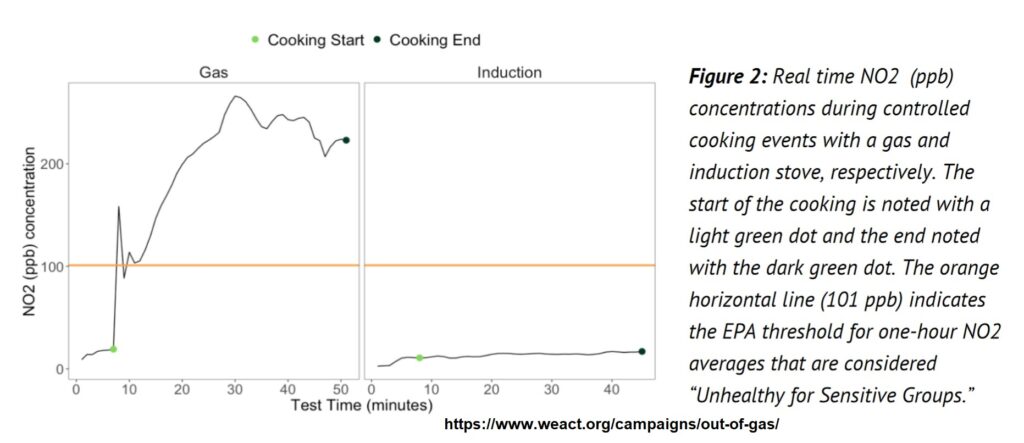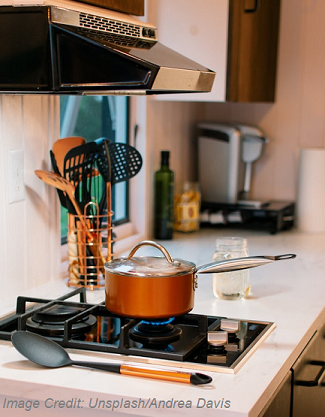We Act for Environmental Justice did a pilot in a NYC Housing Authority Building. They replaced the gas stoves in 10 apartments with electric induction stoves. They found that during cooking, levels of nitrogen dioxide (NO2) were much lower in apartments with induction stoves than in 10 apartments that still had their same gas stoves.
During the pilot, chose 20 apartments in the same housing authority building. They measured NO2 levels in all 20 apartments. Then they replaced the gas stoves in 10 of the apartments with electric induction stoves, and after that measured NO2 levels in all 20 apartments. None of the apartments had exhaust fans that vented to the outside.
During cooking, the NO2 levels from induction stoves in apartments stayed about the same as background. You can see this on the right side of the graph below (Figure 2) where the line is basically flat.
During cooking with gas stoves, the NO2 levels went over 100ppb in less than 10 minutes, and went over 200ppb in about 20 minutes. You can see this on the left side of the graph below where the line goes up sharply and stays up. EPA does not have standards for indoor NO2 levels, but the EPA standard for 1 hr of exposure to NO2 outdoors is 100ppb. This is the orange line on the graph, and it represents a “code orange” or Unhealthy For Sensitive Groups with the EPA Air Quality Index (AQI).

Because children are more affected by air pollution and because children’s lungs keep growing from birth through the teen years (teens’ lungs have a growth spurt just like their bones do), ALL children are considered to be a Sensitive Group by the EPA. Scientific studies show that NO2 really damages children’s and teens’ lung growth. Children with asthma are even more affected by NO2, it can trigger asthma attacks, and NO2 is likely one of the factors that cause children to develop asthma.
The study also looked at NO2 levels that fall into the “code yellow” or Moderate category of the AQI for NO2. The yellow/moderate level begins at 54ppb for one hour. The study found that the 10 apartments with gas stoves averaged 56 minutes a day above this threshold, while the 10 apartments with induction stoves averaged only 4 minutes a day above this threshold.
We also know that NO2 affects adult health too, leading to more breathing troubles, more heart problems, and increased deaths. People 65 and older have an increased risk of death when long-term (annual) levels are higher. One of the residents who had her gas stove switched out for an induction stove commented: “I definitely noticed the difference. I have asthma and didn’t know that the gas stove was contributing to it. Now I have no cough, and I don’t feel congested like before.”
Both the American Medical Association and the American Public Health Association have policy statements that say that gas stoves are a public health concern.
WE ACT also found higher levels of carbon monoxide while cooking with gas stoves compared to cooking with induction stoves, though both levels were below EPA’s standard for outdoor carbon monoxide.
The apartments in this pilot did not have kitchen exhaust fans that vent to the outside, just like the stove hood in this photo. Any pollution made by cooking remains in the apartment, unless people open their windows while cooking.
This report shows that changing stoves from gas to electric induction stoves markedly reduces levels of air pollution and improves indoor air quality in apartments. Based on what we know about NO2 with outdoor air pollution, we can expect that replacing gas stoves in homes would have significant health benefits. WE ACT has a lot of detailed policy recommendations in this report, and we recommend you share these with your officials who set housing codes, regulate apartments, and more.
The Inflation Reduction Act (IRA) that was signed into law last year contains a lot of tax credits or price rebates for people who buy stoves. But it doesn’t seem to have any provisions to help people who rent unless they buy a stove with their own money, and it doesn’t seem to have provisions that encourage landlords to replace gas stoves or at least add exhaust fans that vent to the outside. We need to figure out how to use the funds in the IRA to help renters live with healthy air. Because of historic and ongoing systemic biases in our economic system, Black and brown people are more likely to live in rental housing. We need to address these biases, and we also need to use the IRA to decrease disparities.
02/08/2023





